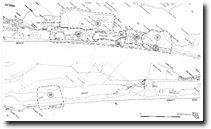GL32 Sperm Whale Head
|
This information has been developed from the publications:
|
| Location: | Easting 600 to Easting 700, Northing 940 to Northing 005. | |
| Abstract: | Barrier formations, dunes and dune lakes; relict entrance channels; tidal delta islands. | |
| Access: | Road to Sperm Whale Head and Rotomah Island. Boat access only to other areas. | |
| Ownership: | Some Crown Land (The Lakes National Park and Gippsland Lakes Coastal Park), private land. | |
| Geology: | All materials exposed here of Quaternary origin and include Pleistocene and Holocene barriers, dune rings, beach and lake shore sands, and swamp deposits. | |
| Geomorphology: | Sperm Whale Head consists of approximately 15 well-defined low, wide parallel ridges, predominantly sandy without the prominent coarse wide parallel sands, grits and gravels that characterize the oldest barriers (prior barrier) seen at Banksia Peninsula to the north. The swales between the ridges are apparently built during a Pleistocene higher sea level phase. The sands are deeply leached with a hard brown alluvial sandrock horizon at depths of one to three metres exposed in cliffed sections on the south-eastern shore near Trapper Point. The parallel ridges have been extensively modified along the northern shore by large parabolic dunes (now inactive). The swales of these dunes are now occupied by lagoons and swamps, and borings into these reveal deflation to several metres below present sea level. They were evidently formed at a lower sea level and are further evidence for the Pleistocene age of the inner barrier here. Much of the northern shore of Sperm Whale Head is eroding exposing cliffed sections in the arms of the parabolic dunes. At Point Wilson a long, narrow sand spit is extending into Lake Victoria. | |
| Significance: | National. (Sites GL 28, GL29, GL30, GL31 and GL32). The association of features here is of major importance in illustrating the evolution of the barrier systems of the Gippsland Lakes. Many details still remain to be worked out concerning the sequence of Pleistocene and Holocene depositional and erosional events and the sites described could be the subject of major studies in geomorphology supported by stratigraphy, palynology and radiometric dating. | |
| Management: | The area requires maximum protection. Extensive grazing, trampling, construction works, roadworks, dredging or quarrying will lead to destruction of sensitive sand ridges and wetlands and could cause mobilization of dunes. | |



